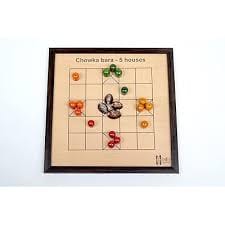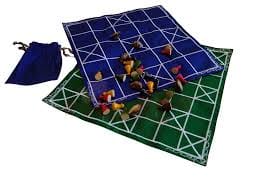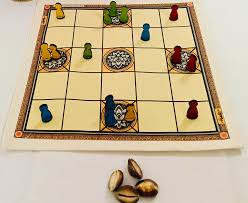Chowka Bara
Chowka Bara, also known as Ashta Chamma, is a traditional Indian board game that weaves together strategy, chance, and cultural heritage. Played on a grid-based board with cowrie shells as dice, this ancient game has entertained generations in South India, particularly in Karnataka, Andhra Pradesh, and Tamil Nadu. Known by names like Katte Mane, Daayam, or Indian Ludo, Chowka Bara blends the thrill of racing with tactical decision-making, making it a cherished pastime for families and friends. This article explores the game’s origins, mechanics, cultural significance, and enduring appeal, highlighting why it remains a vibrant part of India’s gaming tradition.

Origins and Historical Significance
Chowka Bara traces its roots to ancient India, with possible references in epics like the Mahabharata, where dice games symbolized fate and strategy. Believed to have originated in present-day Andhra Pradesh, Telangana, or Karnataka, the game belongs to the cross-and-circle family, alongside Pachisi and Chaupar, and is considered a precursor to modern Ludo. Its name, translating to “four eight” in Kannada, reflects the highest rolls achievable with cowrie shells—four (Chamma) and eight (Ashta).
Historically, Chowka Bara was played during festivals and family gatherings, often on a silk cloth or chalk-drawn board, using tamarind seeds or wooden pawns as tokens. Its simplicity allowed it to thrive in rural settings, while its strategic depth captivated players across generations. Today, organizations and cultural groups are reviving Chowka Bara through workshops and tournaments, ensuring its legacy endures in a digital age.
How to Play Chowka Bara
Chowka Bara is typically a two- or four-player game, though variants support three players or teams. The standard board is a 5×5 grid, but larger versions, like 7×7 or 11×11, accommodate more players, with each player receiving N-1 pawns (e.g., four pawns for a 5×5 board). The objective is to move all pawns from a player’s starting home square (marked with an “X”) to the central square, navigating a spiral path.
Game Setup and Mechanics
- Board: The 5×5 board features a cross-and-circle design, with the central square and middle squares on each edge marked as safe zones where pawns cannot be captured. Players start at their designated home squares on the outermost ring.
- Cowrie Shells: Four cowrie shells serve as dice. The number of shells landing mouth-up determines the move: one (1), two (2), three (3), four (Chamma, 4), or zero (Ashta, 8, when all shells land mouth-down). Rolling a 4 or 8 grants an extra turn, but players must roll a 1, 2, or 3 to move a pawn. Some variants require a 4 or 8 to enter a pawn onto the board.
- Movement: Pawns move in a spiral path, counterclockwise in the outer squares and clockwise in the inner squares, toward the central square. Players choose which pawn to move, strategizing to optimize progress or block opponents. An exact roll is needed to enter the central square.
- Capturing: Landing on a square occupied by an opponent’s single pawn “kills” it, sending it back to its home square. The capturing player earns an extra turn. However, safe zones (cross-marked squares) prevent captures. To enter the inner squares, a player must capture at least one opponent’s pawn, adding a strategic layer.
- Doubles: If two of a player’s pawns occupy the same outer square, they form a double, blocking opponents’ pawns for one turn. Opponents cannot cross a double, and attempting to do so voids their move, costing them a turn. Doubles can be moved together or split, offering tactical flexibility. This rule doesn’t apply in the inner squares.
Winning the Game
The first player to move all their pawns to the central square wins. If all of a player’s pawns reach the inner circle but they haven’t captured an opponent’s pawn, they must continue circling the outer squares until they do. This rule ensures competitive balance and rewards strategic aggression.
Why Chowka Bara Endures
Chowka Bara captivates with its blend of luck and strategy. The cowrie shells introduce unpredictability, while choosing which pawn to move demands foresight. Players must balance advancing their pawns, capturing opponents, and forming doubles to block rivals, creating a dynamic and engaging experience.
The game’s accessibility is a key strength. Requiring only a board (often drawn with chalk), cowrie shells, and tokens, it’s easy to set up in any setting. Its portability and low cost make it ideal for rural communities, while handcrafted sets from artisans in Channapatna, Karnataka, add aesthetic appeal with silk mats and lacquered pawns.
Chowka Bara fosters social interaction, bringing families together during festivals or casual evenings. Its team-play option, where opposite players pair up, enhances collaboration, while local chants and house rules add regional flavor. The game’s adaptability—supporting 5×5, 7×7, or 11×11 boards—ensures it suits various group sizes and skill levels.
Educational and Cognitive Benefits
Chowka Bara is more than entertainment; it’s a tool for learning. For children, it develops counting skills, strategic planning, and patience, as they wait for favorable rolls. The game hones decision-making, as players weigh risks like pursuing a capture versus advancing toward the center. Its mathematical elements, like calculating moves or splitting rolls between pawns, align with early education goals.
In classrooms, Chowka Bara is used to teach probability and spatial reasoning. Its cultural context also makes it a valuable lesson in Indian heritage, connecting students to their roots. For adults, the game sharpens critical thinking and fosters social bonds, making it a versatile activity for all ages.
Cultural Impact and Modern Revival
Chowka Bara remains a cultural touchstone, especially in South India. Played during festivals like Diwali, it evokes nostalgia and strengthens family ties. Online communities on platforms like Reddit and blogs like Kreeda Kaushalya share strategies and variations, while mobile apps, such as those by Gplus Games, bring Chowka Bara to digital platforms, preserving its essence for tech-savvy players.

Recent efforts by cultural organizations and brands like Roll the Dice have sparked a revival, with handcrafted sets and workshops introducing the game to younger generations. Schools in Karnataka and Telangana host Chowka Bara tournaments, blending tradition with modern engagement.
Conclusion
Chowka Bara is a testament to the enduring power of traditional games. Its seamless blend of chance, strategy, and cultural richness makes it a standout in India’s gaming heritage. From silk mats to mobile apps, Chowka Bara adapts while retaining its core appeal, uniting players across generations. As India balances modernity with tradition, this cross-and-circle game remains a vibrant link to the past, proving that a simple roll of cowrie shells can spark hours of joy and connection.
